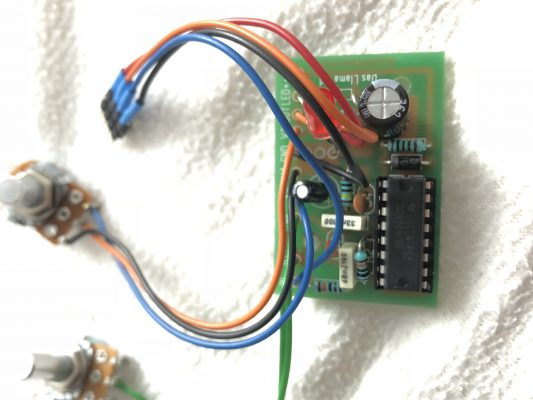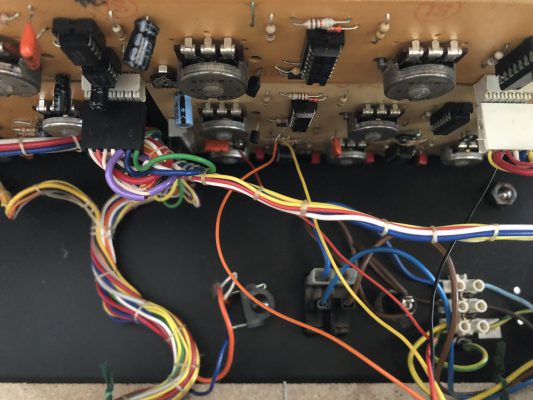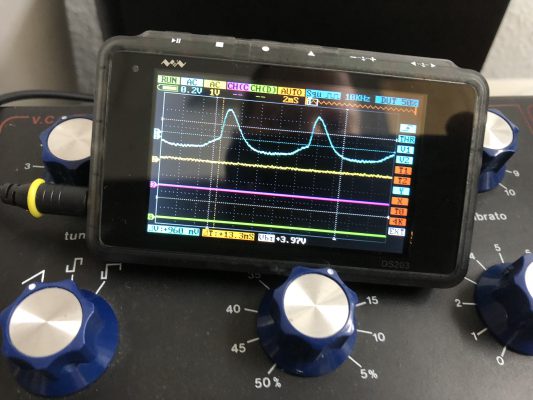Giving my JEN SX-1000 a bit of additional low growl by adding a pre-filter overdrive.
A nice little addition: Insert a booster circuit kit where the coupling capacitor between oscillator and the filter used to be. Come on, you’ll have to take out that damn capacitor anyway. And it sounds really nice, punching through the mix (samples below) – especially in combination with the sub-oscillator mod.
I do admit that you might think that this is a superfluous mod. After all, when you drive this circuit – any circuit – into overdrive and into clipping, the resulting wave form will, gradually, start to resemble a square wave.
But I could do it, so I did it. And I like it. So let’s get started.
The Booster
This is what we are going to use:
This is a small overdrive kit based on a circuit you probably would not think as rock’n’roll: a plain, old 4049 CMOS inverter, the type of early logic chip that was already around for years when Jenny was built, although here it is used in the buffer-less variant (4049UB) you won’t meet very often in the wild. You can buy the overdrive as a nice, cheap kit called “Llama” here, like I did after starting to build a rip-off copy and then realising that the great people at Das Musikding do a much better job than I could.
In a guitar amp, you would have the amp/speaker system to take off the edge of the distorted sound – this is why I decided to add it pre-filter, as a wave-shaper rather than as a post-VCA effect. Thus, no dynamics. The advantage is that, with the booster, you get a bit of additional distortion from the filter.
Where do all the small waveshaper circuits go?
The natural insertion point for a pre-filter booster is this:
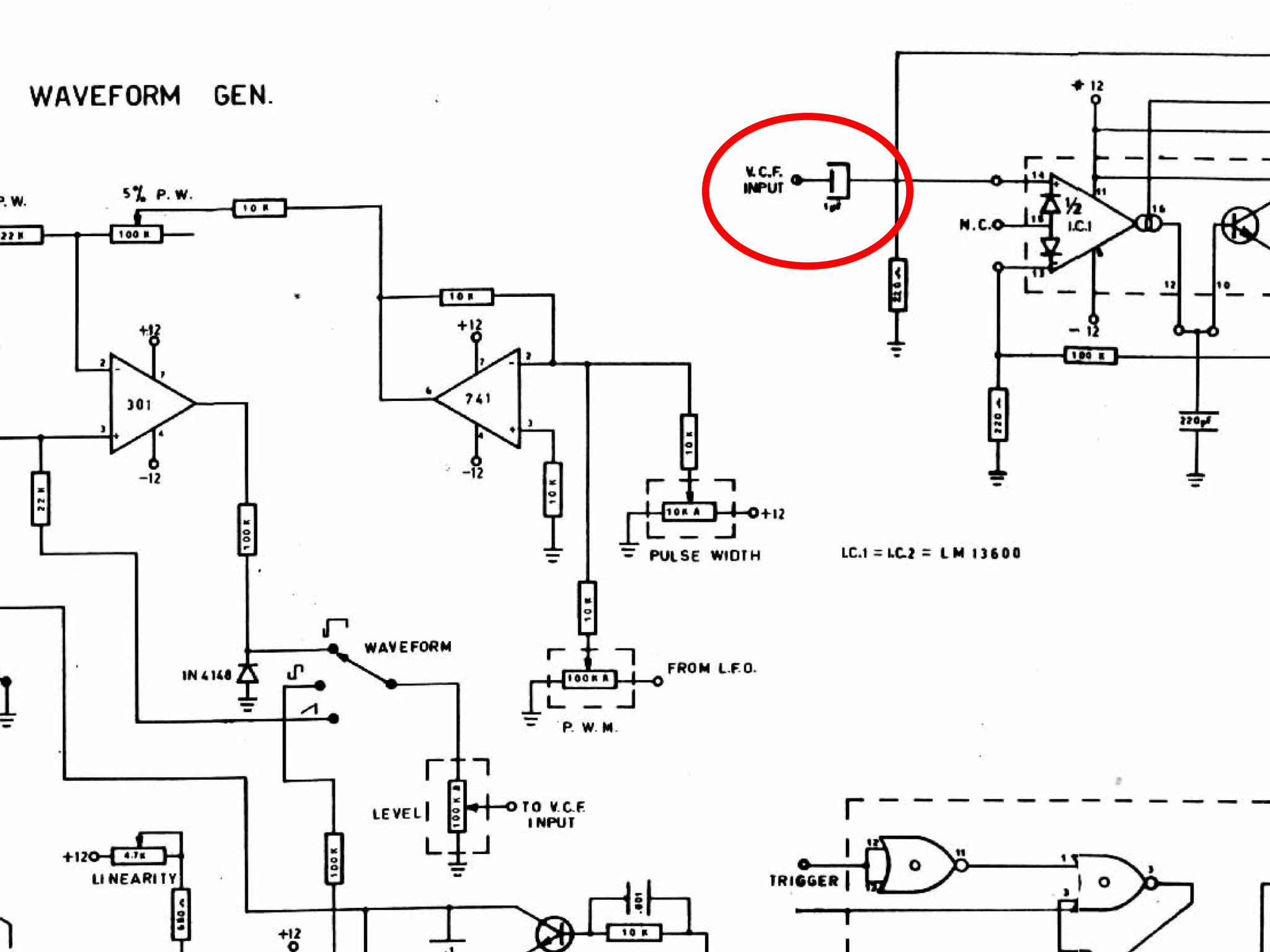
As JEN modders near and far agree, this capacitor should be replaced anyway. Using a larger capacitor – something around at least 10µF – gives Jenny’s sound more bass foundation.
Instead of soldering in the larger cap, I wired the In and Out to a small connector together with GND and +12V, creating a patch point:
Cables were just long enough to have the overdrive circuit outside:
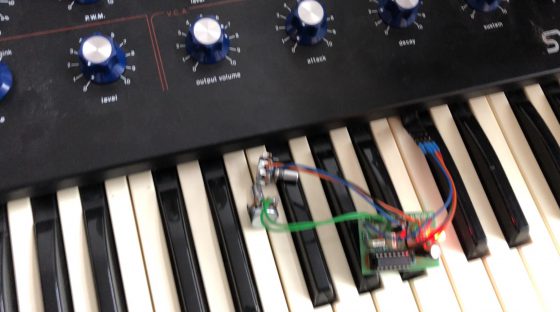
The two potentiometers control amplification, and output level – adjust the 10k output pot to a level where you still get clean sounds but make sure the output level is high enough to have the filter go into self-oscillation when necessary. More on adjusting the amp gain below.
Okay, but how does it sound? (And look?)
I tweaked the 1M amp/feedback pot until the sound stayed just about clean and neutral with the JEN’s VCO level control set to about one-third (set to sawtooth, no sub-oscillator).
On increasing the VCO level beyond 1/3, the overdrive starts kicking in:
Turning it to about 2/3rds, clipping evident here:
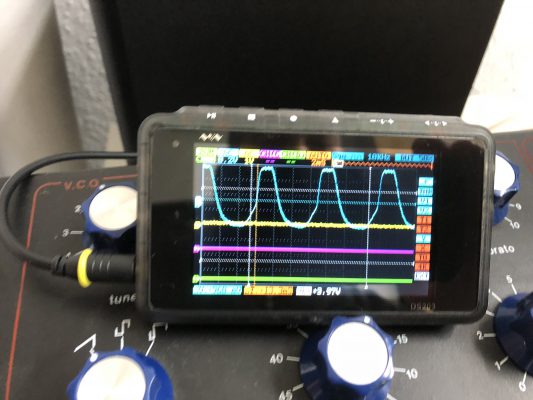
Full volume gives you a (slightly slurred) square wave:
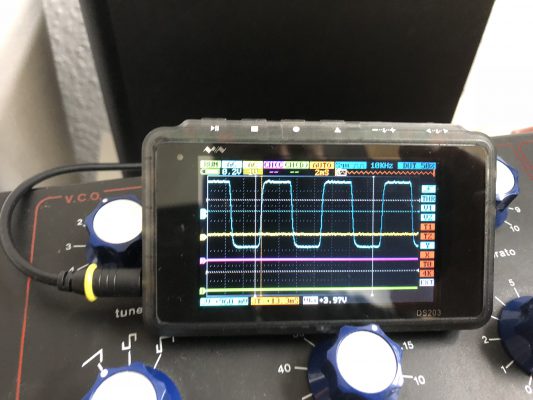
Okay, so is it worth it? This is very subjective but especially with a bit of sub-oscillator I perceive the overdrive as quite organic, warm, and adding to the bottom of the signal, especially with bass sounds, which the JEN is said to be not that good at.
To prove my point: This is a short clip from a jam session with the JEN doing the bass, holding out quite well against a massive guitar and beatbox/synth wall.
Well, I do know that there are a couple of factors playing in Jenny’s favour here – mono voice, no FX to take the edge of the signal – but I am still quite satisfied with the overdrive. I guess it will stay.
Update, 17-Nov-18: Proper calibration
My workbench tests made me notice that the signal for the overdrive has to be attenuated to have some headroom – so I added a 100k pot as a voltage divider, the end terminals wired to the synth’s VCO and to GND respectively, and the mid terminal to the overdrive’s input. Set this input pot to about 1/3rd, adjust the gain to about 1/4th, and set the overdrive’s output level to something like 10-15%, and you are getting this:
Starting at about mid-range, the “level” knob goes into overdrive all up to a squaretooth-y but still pleasant clipped wave. The filter is still capable of going into self-oscillation (if it isn’t, adjust the overdrive’s output level upwards), and the sound is lovely and creamy.
Originally, I was about to add a big, red “Overdrive!” button to the front panel, but now I am just going to leave it as it is. Next stop: bug-fixing and integrating the phaser you can already spot in the video above.
Verwandte Artikel:
- Midifying Jenny, Step 1: Replacing the old keyboard chip with a Teensy (Sunday, 6. January 2019; Schlagworte: Arduino, Jen SX-1000, Löten, Midi, Modding, Retro, Synthesizer, Teensy)
- Adding a slightly odd sub-oscillator circuit to Jenny (Wednesday, 11. February 2015; Schlagworte: Jen SX-1000, Modding, overdrive, sub-oscillator)
- Keytek CTS-2000: Fondly remembering a truly horrible synth (Sunday, 26. October 2014; Schlagworte: 8-bit, CTS-2000, Keytek, synthesizers, vintage)
